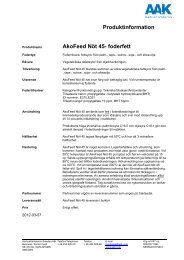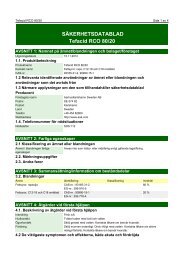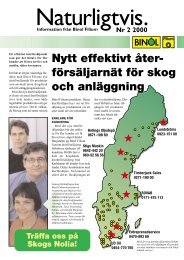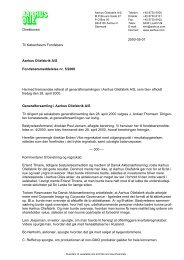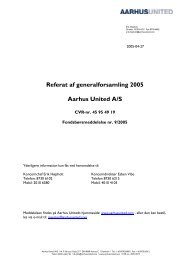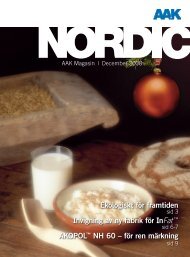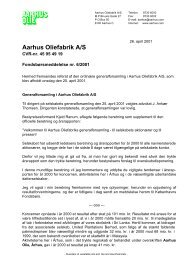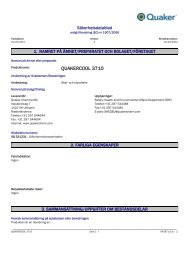Ice-cream fats - AAK
Ice-cream fats - AAK
Ice-cream fats - AAK
You also want an ePaper? Increase the reach of your titles
YUMPU automatically turns print PDFs into web optimized ePapers that Google loves.
<strong>Ice</strong>-<strong>cream</strong> <strong>fats</strong>
<strong>AAK</strong><br />
– your partner in creating solutions<br />
Understanding customer needs is our business<br />
<strong>AAK</strong> is a world leading supplier of high value-added speciality <strong>fats</strong>. In<br />
every customer relationship, our role is to contribute to the competitiveness<br />
of our customers in their respective markets. We offer a wide<br />
range of product advantages; from highly nutritional products, products<br />
developed for better functionality, taste and longer shelf life, to cost<br />
efficiency.<br />
Company<br />
<strong>AAK</strong>´s wide product portfolio meets customer requirements worldwide.<br />
Our customers represent a wide range of industries; Food, Infant Nutrition,<br />
Confectionery, Cosmetics, Technical and Feed. <strong>AAK</strong>’s objective is<br />
to supply innovative and creative, vegetable fat solutions for the benefit<br />
of our customers. <strong>AAK</strong> offers a complete range of oils and <strong>fats</strong> for <strong>Ice</strong><strong>cream</strong>.<br />
Quality and Food safety<br />
<strong>AAK</strong>’s quality comprises the entire product chain – from raw material to<br />
finished product. All of <strong>AAK</strong>’s production units are certified according to<br />
international standard’s.<br />
Research & Development<br />
<strong>AAK</strong>’s knowledge and expertise regarding the properties of vegetable<br />
<strong>fats</strong> develop continuously through customer contacts, cooperation with<br />
research institutes and governmental authorities – regionally and globally.<br />
Our research and development take place in close coordination<br />
with the customer to tailor products to meet the customer’s requirements.<br />
<strong>AAK</strong> ACADEMY <br />
<strong>AAK</strong>’s customer training programme is organised by <strong>AAK</strong> Academy .<br />
The Academy arranges courses and seminars for entire industries as<br />
well as for individual customers.<br />
For further information see www.aak.com<br />
2
Speciality <strong>fats</strong> for ice-<strong>cream</strong> production<br />
Many years’ experience of both chocolate<br />
and ice-<strong>cream</strong> applications enables us to<br />
offer the know-how and ingredients needed<br />
to create both traditional and new types of<br />
ice-<strong>cream</strong> products. The range of specialty<br />
<strong>fats</strong> for use in ice-<strong>cream</strong> production offers<br />
many new opportunities.<br />
The use of vegetable <strong>fats</strong> results in lower<br />
costs and higher production output. It also<br />
makes it possible to give the ice-<strong>cream</strong> a<br />
better nutritional profile, for example by reducing<br />
its content of saturated fat.<br />
Of course, also the quality and safety of<br />
the ingredients are of vital importance. That<br />
is why <strong>AAK</strong> use only the best raw materials,<br />
and soft processes, to ensure that the quality<br />
of the <strong>fats</strong> is the very best.<br />
The experience and resources are available<br />
to give the best possible support<br />
throughout the entire process of developing<br />
a new product. We can produce the<br />
samples you need and assist in plant trials.<br />
<strong>AAK</strong>’s product range offers a complete<br />
range of speciality <strong>fats</strong> for ice-<strong>cream</strong> and<br />
ice-<strong>cream</strong> coatings. The blends are mixtures<br />
of high-quality vegetable oils and are<br />
carefully evaluated at our R&D centre.<br />
Customers become even more competitive<br />
on their respective markets. The contribution<br />
from <strong>AAK</strong> is to offer a market-oriented<br />
product range of the highest quality. We<br />
also provide technical service that improves<br />
the efficiency and provides the best total<br />
economy for customers.<br />
3<br />
www.aak.com
<strong>Ice</strong>-<strong>cream</strong><br />
4<br />
<strong>Ice</strong>-<strong>cream</strong><br />
From a physical point of view, ice-<strong>cream</strong> is<br />
a very complicated product. Selecting the<br />
right ingredients is of utmost importance.<br />
The fat plays an important role in helping to<br />
achieve the desired eating qualities.<br />
Replacing milk fat by vegetable <strong>fats</strong> not<br />
only reduces costs, it also makes the texture<br />
of the ice-<strong>cream</strong> easier to adjust to the<br />
demands specified and allows higher production<br />
output.<br />
Vegetable <strong>fats</strong> also have the important<br />
advantage over milk fat that they make it<br />
possible to balance the content of saturated<br />
and poly-unsaturated <strong>fats</strong> in the composition<br />
and to reduce the cholesterol content.<br />
Fat fulfills different functions in ice<strong>cream</strong>.<br />
This means that a number of properties<br />
are desirable, and describe below.<br />
Lubricant<br />
The fat acts as a lubricant and must melt<br />
properly during eating. The mouth feel is<br />
influenced by several factors such as the<br />
amount of agglomerated fat and the ratio<br />
of solid to liquid fat. Vegetable <strong>fats</strong> used<br />
in ice-<strong>cream</strong> can be constructed in several<br />
different way to give the desired SFC curve<br />
(Figure 1).<br />
Figure 1. Solid fat content for different<br />
ice-<strong>cream</strong> <strong>fats</strong>.<br />
Solid fat content (%)<br />
75<br />
50<br />
25<br />
Milk fat<br />
Akomix E<br />
Akomix DAC<br />
0<br />
10 20 30 40<br />
Temperature (°C)<br />
Structure builder<br />
The texture of an ice-<strong>cream</strong> depends on its<br />
structure. The fat’s performance during aging,<br />
freezing and aeration is very important.<br />
Fat crystals make it possible to incorporate<br />
air cells to give the desired overrun while<br />
at the same time maintaining a smooth texture.
Flavour carrier<br />
The fat has to be of the best quality, and<br />
must also have a bland taste that does not<br />
mask any added flavours.<br />
The structure of ice-<strong>cream</strong><br />
The complexity of the structure and the importantce<br />
to use the appropriate blend of<br />
<strong>fats</strong> can be seen by taking a look at it under<br />
the microscope. The main ingredients<br />
are water, sugar and non-fat milk solids,<br />
and the actual fat content may be no more<br />
than a few per cent. In the finished product,<br />
however, the function of the fat is critical.<br />
It takes the form of small agglomerates on<br />
the surfaces of the incorporated air bubbles<br />
(Figure 2). Stabilizing the air cells is<br />
essential to the ice-<strong>cream</strong>’s texture, and the<br />
perceived eating quality is very much dependent<br />
on it.<br />
Figure 2. Structure of the ice-<strong>cream</strong><br />
<strong>Ice</strong> crystals<br />
(10-75 µm)<br />
Fat crystals (globules)<br />
(0,2-20 µm)<br />
Three dimensional<br />
fat network<br />
Air bubbles<br />
(10-150 µm)<br />
Casein micelles<br />
(0,04-0,4 µm)<br />
5 www.aak.com
<strong>Ice</strong>-<strong>cream</strong> – Production with vegetable fat<br />
<strong>AAK</strong> has developed a special product range<br />
of vegetable <strong>fats</strong> for ice-<strong>cream</strong>, called<br />
Akomix. Milk <strong>fats</strong> can be replaced partly<br />
or completely by Akomix. It is important<br />
to prepare an ice-<strong>cream</strong> mix with the right<br />
physical properties. This is the form in<br />
which the mix will be frozen and together<br />
with the freezing procedure determines the<br />
final result. A good and <strong>cream</strong>y product<br />
can have exactly the same ingredients as<br />
a product with an open and icy character.<br />
The processing is the determining parameter<br />
for a quality ice-<strong>cream</strong> when the mix of<br />
ingredients is the right one.<br />
Processing steps.<br />
Mixing of raw material<br />
Pasteurisation<br />
Homogenisation<br />
Cooling<br />
Aging<br />
Freezing<br />
Hardening<br />
Cold storage<br />
Production with Vegetable Fat<br />
Preparation of ice-<strong>cream</strong> mix<br />
A homogenous mix is of outmost importance<br />
to be able to produce a high-quality<br />
ice-<strong>cream</strong>. There are slightly different ways<br />
to do this. For a good result it is important<br />
that the ingredients are properly dissolved.<br />
1. Skim milk powder can be added and<br />
stirred into water at approximately 40 °C.<br />
The temperature at which skim milk<br />
powder dissolves may vary.<br />
2. The heating is then continued to some<br />
65-70 °C, where the rest of the ingredients<br />
are added. Sugar and emulsifier/<br />
stabiliser can be blended before addition<br />
to the hot water, often making it easier<br />
to dissolve the emulsifier/stabiliser. The<br />
fat and the glucose are added in liquid<br />
form. It is important that the fat is totally<br />
melted before addition to the mix.<br />
During mixing it is also important that the<br />
stirring is vigorous enough to ensure that<br />
all components dissolve and that the mix<br />
is homogenous. To establish that all particles<br />
have been dissolved, a filtration can be<br />
made.<br />
6<br />
Processing of ice-<strong>cream</strong><br />
Whether the ice-<strong>cream</strong> contains milk fat or<br />
vegetable fat, the processing is principally<br />
the same.<br />
The pasteurisation of the mix can be<br />
made either before homogenisation, in the<br />
vessel where the mix is prepared, or after<br />
the homogenisation.<br />
The main exception from mix-preparation<br />
with milk fat is during the homogenisation<br />
step, where the pressure has to be<br />
adjusted. The homogenisation takes place<br />
at temperature between 75-80 °C, the<br />
pressure for mix containing vegetable fat<br />
is lower than for a mix containing <strong>cream</strong> or<br />
butterfat. This is due to the inherent strong<br />
emulsifiers in these systems. There is also<br />
a difference in homogenisation pressure for<br />
mixes with different fat contents. A higher<br />
fat content in the mix needs a lower pressure.<br />
The pressure is also depending upon<br />
the type of homogeniser. In figure 3, the relation<br />
in homogenisation pressure between<br />
the different products is shown.<br />
If the homogenisation has been effective<br />
no fat droplets will show on the surface of<br />
the mix.
The mix is cooled to between 2 and 4 °C<br />
and aged at this temperature for at least<br />
four hours. If the homogenisation was successful,<br />
the aged mix is liquid and homogenous.<br />
An effective homogenisation and a proper<br />
aging-time are important conditions to<br />
obtain a good quality of the finished ice<strong>cream</strong>.<br />
After aging, the mix is frozen and air is<br />
incorporated into the mix. A temperature<br />
of the ice-<strong>cream</strong> when it leaves the freezer<br />
is -5 °C or lower. A higher temperature will<br />
give a less <strong>cream</strong>y and more icy product.<br />
The ice-<strong>cream</strong> is normally hardened at a<br />
temperature between -30 and -40 °C.<br />
Emulsifier/Stabiliser<br />
The emulsifier/stabiliser blends are important<br />
ingredients of an ice-<strong>cream</strong>. If milk<br />
fat is replaced by vegetable fat, the same<br />
amount and type of emulsifier can be used<br />
to begin with. If necessary the level can be<br />
adjusted.<br />
Flavourings and colourings<br />
Liquid flavouings and colourings are normally<br />
added to the cold mix in the aging<br />
tank. Powdered flavourings are often easier<br />
to dissolve in the hot mix before cooling.<br />
A vanilla ice-<strong>cream</strong> made with vegetable<br />
fat may have a slightly weaker taste<br />
than the same type of ice-<strong>cream</strong> containing<br />
milk fat. The milk fat contributes to this<br />
taste, whereas vegetable fat is bland. The<br />
taste can be strengthened by adding more<br />
vanilla flavour.<br />
Figure 3. Homogenization pressure for<br />
different ice-<strong>cream</strong> <strong>fats</strong>.<br />
250<br />
200<br />
150<br />
100<br />
KP/mc 3<br />
Cream<br />
Butter fat<br />
Vegetable fat<br />
2 4 6 8 10 12 14<br />
Fat content (%)<br />
7 www.aak.com
<strong>Ice</strong>-<strong>cream</strong> Coatings<br />
8<br />
<strong>Ice</strong>-<strong>cream</strong> Coatings<br />
Today coatings are commonly used in the<br />
production of ice-<strong>cream</strong>. Since the fat content<br />
of a coating varies between 55 % and<br />
70 %, its properties are mainly coming from<br />
the fat used.<br />
Apart from economic considerations,<br />
vegetable <strong>fats</strong> have an advantage over cocoa<br />
butter in ice-<strong>cream</strong> coatings, as they<br />
are better equipped to meet the special demands.<br />
Particularly when fast crystalli-sation<br />
is critical and non-transparent yet thin<br />
layers are required. <strong>AAK</strong>’s product range for<br />
this application is Akoice.<br />
Below are some of the special demands<br />
that ice-<strong>cream</strong> coatings must meet:<br />
Melting behaviour<br />
A coating have a melting point lower than<br />
30 °C. Otherwise, the coating will not melt<br />
during eating, because mouth temperature<br />
falls when eating ice-<strong>cream</strong>. A coating must<br />
have good snap, and then melt rapidly and<br />
totally to give good mouthfeel. Its SFC curve<br />
is a good indicator in this respect.<br />
Viscosity and plasticity<br />
To simplifying the production process and<br />
ensuring that the whole product is coated<br />
with a thin, non-transparent layer, an ice<strong>cream</strong><br />
coating should have a low viscosity.<br />
If not, ”bleeding” will occur, with the ice<strong>cream</strong><br />
appearing in white spots on the coating.<br />
A coating must also have a somewhat<br />
elastic structure, in order to prevent it from<br />
breaking or chipping off the ice-<strong>cream</strong> during<br />
eating.<br />
Rate of solidification<br />
A coating should have a rapid rate of solidification,<br />
so that production output can be<br />
highly efficient.<br />
Flavour release<br />
Especially in coatings, fast flavour release<br />
is essential. Since the fat is the carrier of<br />
the flavour, it should be chosen with care in<br />
order to guarantee fast flavour release.
Akoice for dippings and toppings<br />
<strong>Ice</strong> dippings or ice toppings are other types<br />
of ice-<strong>cream</strong> coatings, applied at the point<br />
of sale or at home.<br />
They should be liquid at room temperature,<br />
and solidify almost instantly<br />
when they come into contact with cold<br />
ice-<strong>cream</strong>. As the product may be exposed<br />
to room temperature for a longer<br />
period of time, stability against oxidation<br />
and rancidity is important. The quality of an<br />
ice dipping or ice topping is largely determined<br />
by the properties of the fat system.<br />
The product should:<br />
Have low viscosity and be liquid at room<br />
temperature.<br />
Set rapidly.<br />
Have good stability against oxidation.<br />
Show good melt-off properties.<br />
Have good flavour release.<br />
When these requirements are met, the<br />
result will be a crispy, glossy coating with<br />
good snap.<br />
Moisture barrier<br />
Another important application is the utilisation<br />
of <strong>fats</strong> as a moisture barrier between<br />
the ice-<strong>cream</strong> and the waffle of a cone. In<br />
such a product there is usually a migration<br />
of water, from the ice-<strong>cream</strong> to the cone, this<br />
makes the waffle soft and less appetizing.<br />
A moisture barrier in the form of a<br />
thin layer of sprayed chocolate efficiently<br />
puts an end to this problem.<br />
A fat used in this application must fulfill<br />
mostly the same demands as the ones described<br />
at page 8. For this application field,<br />
<strong>AAK</strong> has developed a product line that lives<br />
up to these requirements: called Akoice.<br />
Moisture<br />
barrier.<br />
Air<br />
Wafer<br />
Sprayed<br />
chocolate<br />
H 2 O<br />
H 2 O<br />
<strong>Ice</strong>-<strong>cream</strong><br />
9 www.aak.com
Products and formulas<br />
Akomix<br />
Akomix is the name of a group of products<br />
from <strong>AAK</strong> that have been specially developed<br />
for use in ice-<strong>cream</strong> production. Only<br />
carefully selected, top quality raw materials<br />
are used, to ensure that they meet the<br />
demands made on vegetable <strong>fats</strong> for use in<br />
ice-<strong>cream</strong>.<br />
Akomix can be used to replace milk fat<br />
either completely or partially. <strong>Ice</strong>-<strong>cream</strong><br />
based on Akomix has a better nutritional<br />
fatty acid profile compared to ice-<strong>cream</strong><br />
based on milk fat.<br />
The great advantage of the oil blends are<br />
that they make it possible to balance the<br />
composition of saturated and poly-unsaturated<br />
<strong>fats</strong>, and at the same time achieve a<br />
satisfactory SFC curve.<br />
Akomix is solid at room temperature, and<br />
gives ice-<strong>cream</strong> an excellent consistency<br />
and taste.<br />
Suggestions for ice-<strong>cream</strong> formulas based<br />
on Akomix.<br />
Original<br />
recipe<br />
100 %<br />
veg. fat<br />
60 %<br />
veg. fat<br />
Cream 31 % 22.3 0.0 0.0<br />
Sugar 14.0 14.0 14.0<br />
Skim milk<br />
powder<br />
2.8 14.9 0.0<br />
Milk 3.2 %<br />
Milk powder<br />
56.6 0.0 0.0<br />
20 % 2.0 0.0 18.6<br />
Akomix 0.0 9.5 5.8<br />
Emulsifier/<br />
Stabilizer 0.5 0.5 0.5<br />
Aroma 0.1 0.1 0.1<br />
Colour 0.01 0.01 0.01<br />
Water 1.7 61.0 61.0<br />
Products and formulas<br />
Akoice<br />
Akoice is the name of <strong>AAK</strong>’s range of products<br />
for use in ice-<strong>cream</strong> coatings.<br />
Only carefully selected, top-quality raw<br />
materials are used, to ensure that they meet<br />
the demands made in the production of ice<strong>cream</strong><br />
coatings.<br />
These speciality <strong>fats</strong> are the ideal choice<br />
for ice-<strong>cream</strong> coating production, both in<br />
terms of price and high production output.<br />
Akoice is fluid or semi-fluid at room temperature,<br />
depending on whether the product is<br />
to be used in ordinary ice-<strong>cream</strong> coatings or<br />
in ice dippings/ice toppings or as a moisture<br />
barrier. Akoice gives fast-setting chocolate<br />
layers with no bleeding. The products have<br />
enhanced melting behaviour and shorter<br />
crystallisation times, qualities that are especially<br />
important in high-speed ice bar<br />
machines.<br />
10<br />
<strong>Ice</strong>-<strong>cream</strong> coatings formulas<br />
based on Akoice.<br />
Dark coating<br />
Sugar 22.5%<br />
Cocoa powder (non-alkalized) 12.5%<br />
Akoice 65.0%<br />
Lecithin 0.3%<br />
Vanilla 0.0075%<br />
Salt 0.015%<br />
Milk coating<br />
Sugar 18.5%<br />
Cocoa powder (non-alkalized<br />
content of cocoa butter 12%) 3.5%<br />
Skim milk powder 8.5%<br />
Dextrose 3.0%<br />
Akoice 66.5%<br />
Lecithin 0.3%<br />
Vanilla 0.0065%<br />
One-sixth of Akoice is mixed and milled<br />
with the other ingredients. Another sixth<br />
of Akoice is added into the conch. The<br />
remainings are mixed into the completely<br />
conched mass.
<strong>Ice</strong>-<strong>cream</strong> with health profile<br />
The latest additions to the <strong>AAK</strong> range of<br />
ice-<strong>cream</strong> <strong>fats</strong> are products with improved<br />
health profiles. We have adopted a proactive<br />
approach to reducing the proportion of<br />
saturated fat in the products while, at the<br />
same time, maintaining functionality and<br />
taste. The products are, of course, trans<br />
free. Our new products are called Akomix<br />
LS 40, which contains 40 % saturated fat,<br />
and Akomix LS 30, which contains 30 %<br />
saturated fat.<br />
What makes Akomix special?<br />
They give ice-<strong>cream</strong> an excellent<br />
texture.<br />
They provide the perfect taste experience,<br />
with great melting properties.<br />
They have good storage stability.<br />
They contain low levels of<br />
saturated fat.<br />
They are trans free and do not contain<br />
any hydrogenated fat.<br />
Health trends<br />
A strong health trend which focuses on<br />
saturated fat levels is running through the<br />
whole food industry, and <strong>AAK</strong> is now making<br />
it possible for ice-<strong>cream</strong> manufacturers<br />
to join as well. We have invested in the<br />
development of new products within the<br />
Akomix range, with the aim of minimising<br />
saturated fat levels and increasing the levels<br />
of mono- and polyunsaturated <strong>fats</strong>.<br />
Saturated fat in ice-<strong>cream</strong><br />
At present, ice-<strong>cream</strong> production is based<br />
on <strong>cream</strong> <strong>fats</strong> or a vegetable alternative,<br />
such as coconut.<br />
Ordinary <strong>cream</strong> fat contains fairly high<br />
levels of saturated fat, around 70 %, and<br />
coconut has an even higher level of saturated<br />
fat, over 90 %. In the Akomix range,<br />
we have, until now, worked with saturated<br />
fat levels of 60 % or less. We found it relatively<br />
easy to reduce the level of saturated<br />
fatty acids to 40 % and still maintain the desired<br />
properties of the ice-<strong>cream</strong>. The step<br />
down to 30 %, the level of Akomix LS 30, is<br />
significantly more challenging and requires<br />
the application of advanced fat technology.<br />
The differences in the amount of saturated<br />
fat are shown in Figure 4. Akomix<br />
has significantly lower levels of saturated<br />
fat and considerably higher proportions of<br />
mono- and polyunsaturated fat. Neither<br />
product does, of course, contain trans <strong>fats</strong>.<br />
Properties<br />
Normally, a reduced level of saturated fat<br />
means that hardness and the fat’s ability to<br />
form a network which ensures that the ice<strong>cream</strong><br />
has a good structure falls when the<br />
amount of saturated fat is reduced.<br />
In Akomix LS 30, by selecting the right<br />
ingredients, we have managed to eliminate<br />
the risk of problem that the somewhat softer<br />
<strong>fats</strong> will create in the end product. The new<br />
product provides the end product with an<br />
excellent structure, only causing a slight fall<br />
in hardness while maintaining consistency.<br />
Despite the small amount of saturated fat,<br />
100<br />
90<br />
80<br />
70<br />
60<br />
50<br />
40<br />
30<br />
20<br />
10<br />
0<br />
Coconut oil<br />
Dairy fat<br />
Akomix TS<br />
Akomix LS 30<br />
SAFA MUFA PUFA Trans<br />
Akomix LS 30 generates the same results in<br />
serum separation tests as Akomix TS and<br />
coconut oil.<br />
From a sensory point of view, we have<br />
created a fat which improves the <strong>cream</strong>iness<br />
of ice-<strong>cream</strong> and provides an excellent<br />
taste experience. Figure 5 clearly shows<br />
that Akomix LS 30, despite its lower level<br />
of saturated fat, provides an oral sensation<br />
which is fully comparable with that of traditional<br />
ice-<strong>cream</strong> <strong>fats</strong>.<br />
The only differences that are significant<br />
are that the Akomix LS30 is a little softer,<br />
less icy and less porous (same density,<br />
though). This shows that choosing the right<br />
crystallisation behaviour can produce good<br />
form stability; good heat shook stability and<br />
excellent sensory properties, if the system<br />
is design in the right way.<br />
Figure 4. Fatty acid composition. Figure 5. Sensory evaluation of ice-<strong>cream</strong>.<br />
Chewy<br />
Rapid<br />
melt-down<br />
Creamy<br />
Complete melt-down<br />
Fresh/ice<br />
<strong>cream</strong>-like<br />
Coconut oil Akomix LS 30<br />
Porous<br />
11 www.aak.com<br />
Icy<br />
Hard
For more information:<br />
info.products@aak.com<br />
Telephone: +46 454 82000<br />
<strong>AAK</strong> – Wherever you are<br />
Sales offices<br />
Production<br />
The first choice for value-added<br />
vegetable oil solutions<br />
<strong>AAK</strong> is the world’s leading manufacturer of<br />
high value-added speciality vegetable oils<br />
and <strong>fats</strong>. The many advantages of these natural<br />
and renewable raw materials create opportunities<br />
in the market segments of confectionery,<br />
food, infant nutrition and beauty and<br />
personal care.<br />
The advantage of <strong>AAK</strong>’s product portfolio<br />
is that it consists of natural vegetable oils<br />
and <strong>fats</strong> that have a low saturated fat content<br />
and contain desired properties that promote<br />
healthier lifestyles.<br />
<strong>AAK</strong> offers total value-added solutions.<br />
These are comprehensive packages of benefits<br />
like new product development, customization,<br />
market advice, delivery systems, technical<br />
support and <strong>AAK</strong> ACADEMY .<br />
<strong>AAK</strong>’s head office is in Malmö, Sweden,<br />
and we have production facilities in Denmark,<br />
Mexico, the Netherlands, Great Britain,<br />
Sweden, Uruguay and USA. <strong>AAK</strong> also have<br />
sales offices and agents/distributors all over<br />
the world. So no matter where you are, you’re<br />
within reach of <strong>AAK</strong>, the first choice for valueadded<br />
vege table oil solutions.<br />
www.aak.com






